Page 184 of 611

1752007 TUNDRA from Jul. ’07 Prod. (OM34463U)
�When opening and closing the doors
To turn on: Open any of the doors.
To turn off: Close all the doors.
�When the ignition switch is in the “ON”
position, the cargo lamp will go off im-
mediately.
�When the ignition switch is in the
“LOCK” position or the key is removed,
the cargo lamp will automatically go off
after 15 seconds.
To prevent the battery being discharged,
the lights will automatically turn off in
about 20 minutes after the ignition key is
removed.
This feature is deactivated when the igni-
tion switch is in the “ON” position.
XS15018b
The lights will come on when the doors
are unlocked simultaneously using either
the power door lock switches or the wire-
less remote control. This light remains on
for 15 seconds before fading out when
any door is opened, and additional 15
seconds after all the doors are closed.
However, in the following cases, the light
goes off immediately.
�Doors are locked with wireless remote
control.
�The selector lever is put in a position
other than “P” with the ignition switch
on.
�The doors are locked via the driver’s
door key cylinder.
�The doors are locked via the switches
either inside the driver ’s or front pas-
senger ’s door.
Exterior foot lights (with
driving position memory
system)
Page 185 of 611
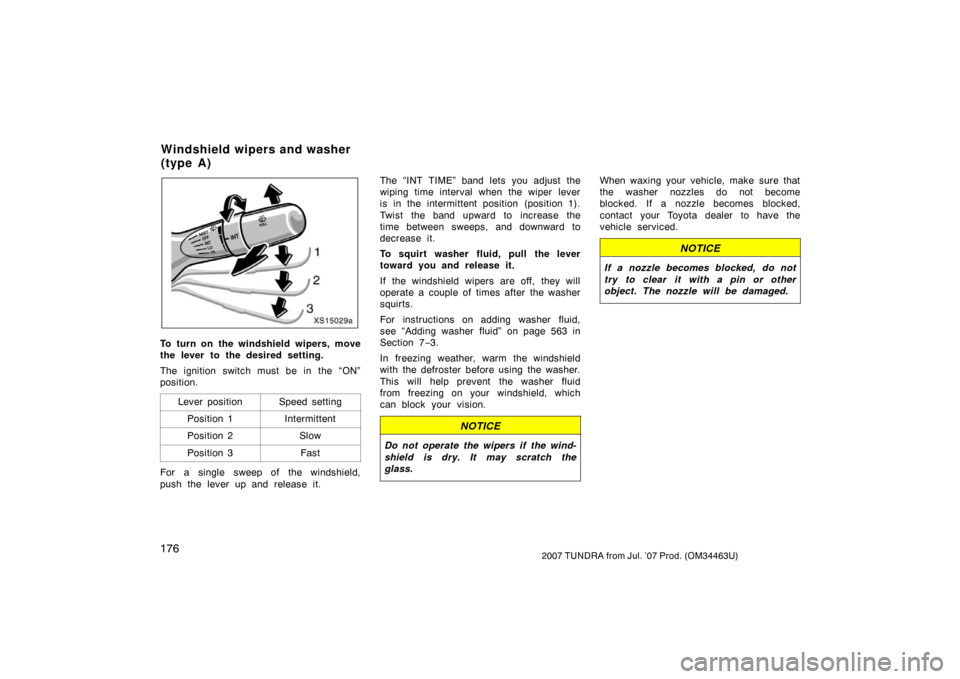
1762007 TUNDRA from Jul. ’07 Prod. (OM34463U)
XS15029a
To turn on the windshield wipers, move
the lever to the desired setting.
The ignition switch must be in the “ON”
position.Lever position
Speed setting
Position 1Intermittent
Position 2Slow
Position 3Fast
For a single sweep of the windshield,
push the lever up and release it. The “INT TIME” band lets you adjust the
wiping time interval when the wiper lever
is in the intermittent position (position 1).
Twist the band upward to increase the
time between sweeps, and downward to
decrease it.
To squirt washer fluid, pull the lever
toward you and release it.
If the windshield wipers are off, they will
operate a couple of times after the washer
squirts.
For instructions on adding washer fluid,
see “Adding washer fluid” on page 563 in
Section 7
−3.
In freezing weather, warm the windshield
with the defroster before using the washer.
This will help prevent the washer fluid
from freezing on your windshield, which
can block your vision.
NOTICE
Do not operate the wipers if the wind-
shield is dry. It may scratch the
glass.
When waxing your vehicle, make sure that
the washer nozzles do not become
blocked. If a nozzle becomes blocked,
contact your Toyota dealer to have the
vehicle serviced.
NOTICE
If a nozzle becomes blocked, do not
try to clear it with a pin or other
object. The nozzle will be damaged.
Windshield wipers and washer
(type A)
Page 186 of 611
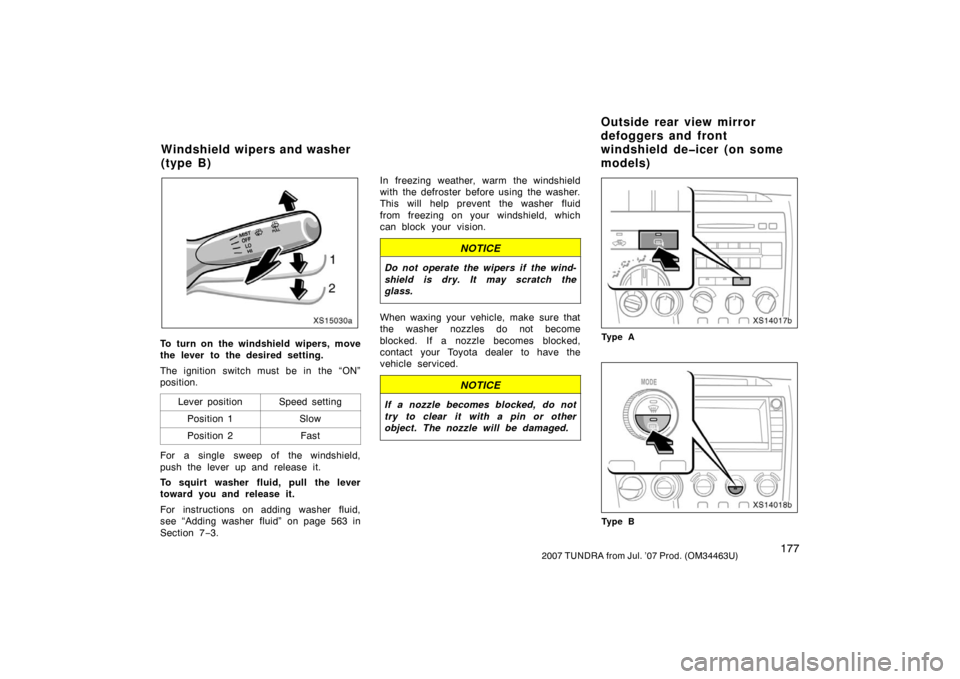
1772007 TUNDRA from Jul. ’07 Prod. (OM34463U)
XS15030a
To turn on the windshield wipers, move
the lever to the desired setting.
The ignition switch must be in the “ON”
position.Lever position
Speed setting
Position 1Slow
Position 2Fast
For a single sweep of the windshield,
push the lever up and release it.
To squirt washer fluid, pull the lever
toward you and release it.
For instructions on adding washer fluid,
see “Adding washer fluid” on page 563 in
Section 7 −3. In freezing weather, warm the windshield
with the defroster before using the washer.
This will help prevent the washer fluid
from freezing on your windshield, which
can block your vision.
NOTICE
Do not operate the wipers if the wind-
shield is dry. It may scratch the
glass.
When waxing your vehicle, make sure that
the washer nozzles do not become
blocked. If a nozzle becomes blocked,
contact your Toyota dealer to have the
vehicle serviced.
NOTICE
If a nozzle becomes blocked, do not
try to clear it with a pin or other
object. The nozzle will be damaged.
XS14017b
Ty p e A
XS14018b
Ty p e B
Windshield wipers and washer
(type B)
Outside rear view mirror
defoggers and front
windshield de�icer (on some
models)
Page 187 of 611
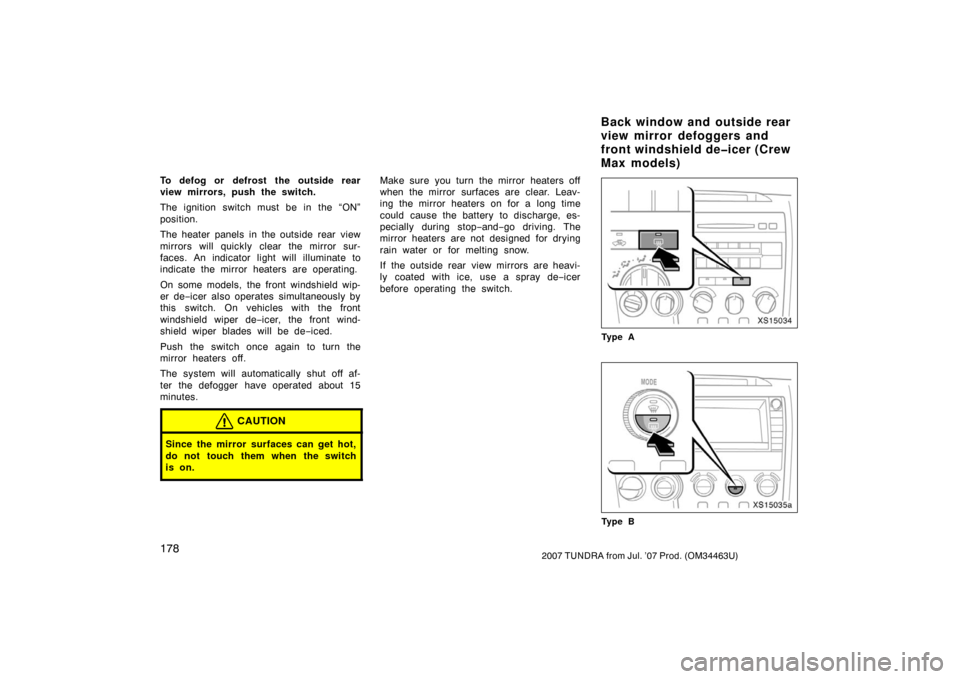
1782007 TUNDRA from Jul. ’07 Prod. (OM34463U)
To defog or defrost the outside rear
view mirrors, push the switch.
The ignition switch must be in the “ON”
position.
The heater panels in the outside rear view
mirrors will quickly clear the mirror sur-
faces. An indicator light will illuminate to
indicate the mirror heaters are operating.
On some models, the front windshield wip-
er de−icer also operates simultaneously by
this switch. On vehicles with the front
windshield wiper de −icer, the front wind-
shield wiper blades will be de −iced.
Push the switch once again to turn the
mirror heaters off.
The system will automatically shut off af-
ter the defogger have operated about 15
minutes.
CAUTION
Since the mirror surfaces can get hot,
do not touch them when the switch
is on.
Make sure you turn the mirror heaters off
when the mirror surfaces are clear. Leav-
ing the mirror heaters on for a long time
could cause the battery to discharge, es-
pecially during stop −and− go driving. The
mirror heaters are not designed for drying
rain water or for melting snow.
If the outside rear view mirrors are heavi-
ly coated with ice, use a spray de −icer
before operating the switch.
XS15034
Ty p e A
XS15035a
Ty p e B
Back window and outside rear
view mirror defoggers and
front windshield de�icer (Crew
Max models)
Page 191 of 611
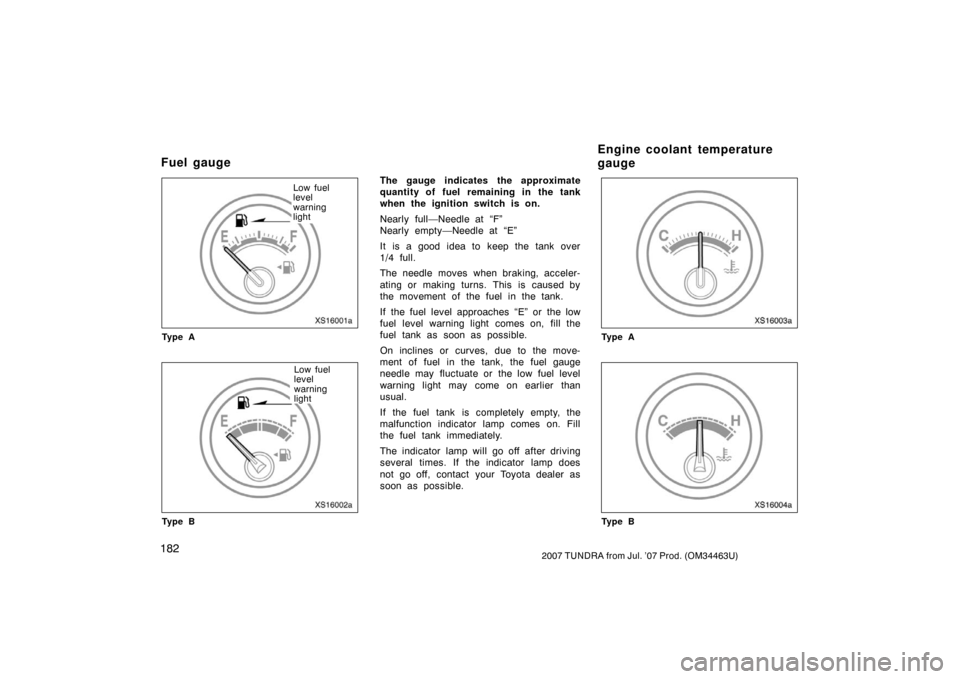
1822007 TUNDRA from Jul. ’07 Prod. (OM34463U)
XS16001a
Low fuel
level
warning
light
Ty p e A
XS16002a
Low fuel
level
warning
light
Ty p e B
The gauge indicates the approximate
quantity of fuel remaining in the tank
when the ignition switch is on.
Nearly full—Needle at “F”
Nearly empty—Needle at “E”
It is a good idea to keep the tank over
1/4 full.
The needle moves when braking, acceler-
ating or making turns. This is caused by
the movement of the fuel in the tank.
If the fuel level approaches “E” or the low
fuel level warning light comes on, fill the
fuel tank as soon as possible.
On inclines or curves, due to the move-
ment of fuel in the tank, the fuel gauge
needle may fluctuate or the low fuel level
warning light may come on earlier than
usual.
If the fuel tank is completely empty, the
malfunction indicator lamp comes on. Fill
the fuel tank immediately.
The indicator lamp will go off after driving
several times. If the indicator lamp does
not go off, contact your Toyota dealer as
soon as possible.
XS16003a
Ty p e A
XS16004a
Ty p e B
Fuel gaugeEngine coolant temperature
gauge
Page 192 of 611
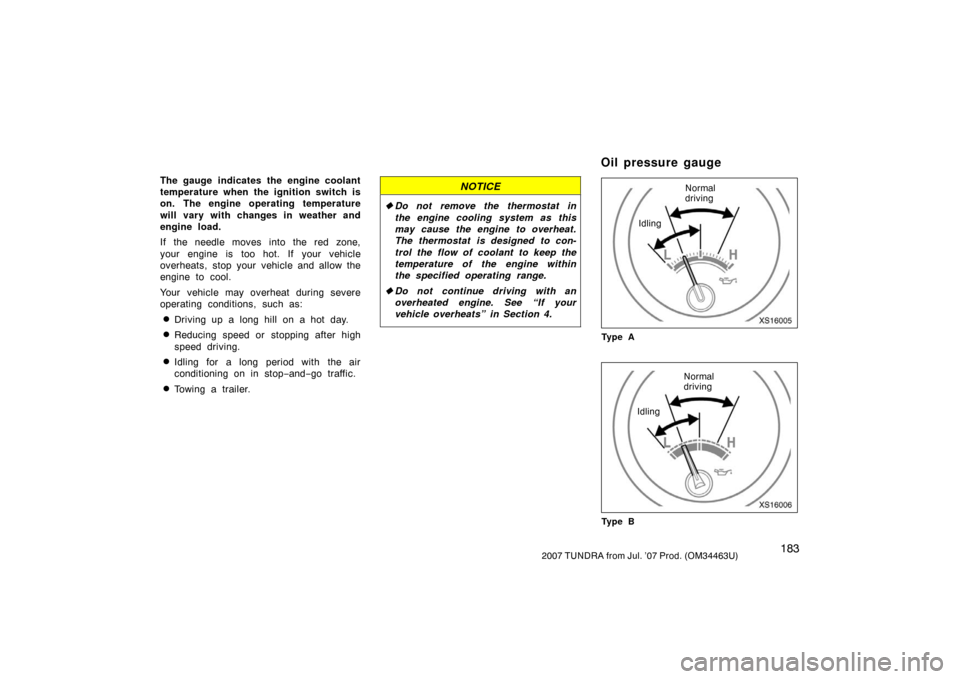
1832007 TUNDRA from Jul. ’07 Prod. (OM34463U)
The gauge indicates the engine coolant
temperature when the ignition switch is
on. The engine operating temperature
will vary with changes in weather and
engine load.
If the needle moves into the red zone,
your engine is too hot. If your vehicle
overheats, stop your vehicle and allow the
engine to cool.
Your vehicle may overheat during severe
operating conditions, such as:
�Driving up a long hill on a hot day.
�Reducing speed or stopping after high
speed driving.
�Idling for a long period with the air
conditioning on in stop−and− go traffic.
�Towing a trailer.
NOTICE
�Do not remove the thermostat in
the engine cooling system as this
may cause the engine to overheat.
The thermostat is designed to con-
trol the flow of coolant to keep the
temperature of the engine within
the specified operating range.
� Do not continue driving with an
overheated engine. See “If your
vehicle overheats” in Section 4.
XS16005
Normal
driving
Idling
Ty p e A
XS16006
Normal
driving
Idling
Ty p e B
Oil pressure gauge
Page 193 of 611

1842007 TUNDRA from Jul. ’07 Prod. (OM34463U)
The oil pressure gauge indicates engine
oil pressure when the ignition switch is
on. Check it while driving to make sure
that the needle is in the proper range.
If the oil pressure should stay below the
normal range, pull off the road to a safe
place and stop the engine immediately.
Call a Toyota dealer or qualified repair
shop for assistance.
Oil pressure may not build up when the
oil level is too low. The oil pressure
gauge is not designed to indicate oil level,
and the oil level must be checked using
the level dipstick.
NOTICE
Do not drive the vehicle with the oil
pressure below the normal range until
the cause is fixed—it may ruin the
engine.
XS16015c
High range
Ty p e A
XS16016c
High range
Ty p e B
Automatic transmission fluid tempera-
ture gauge indicates automatic trans-
mission fluid temperature when the
ignition switch is on. Check it while
driving to make sure that the needle is
in the proper range.
The gauge displays the current tempera-
ture of the automatic transmission fluid.
The gauge informs the driver of changes
in the automatic transmission fluid temper-
ature especially if it becomes too high
while towing a heavy trailer or hauling a
heavy load.
If the needle reads high range while you
are driving, slow down and pull off the
road. Stop the vehicle at a safe place and
put the selector lever in “P”. With the
engine idling, wait until the needle reads
below the high range. If the needle reads
below the high range, you may start the
vehicle again. If the needle reads the high
range, call a Toyota dealer or qualified
repair shop for assistance.
NOTICE
Continued driving with reading in the
high range may damage the automatic
transmission.
Automatic transmission fluid
temperature gauge (with
towing package)
Page 196 of 611
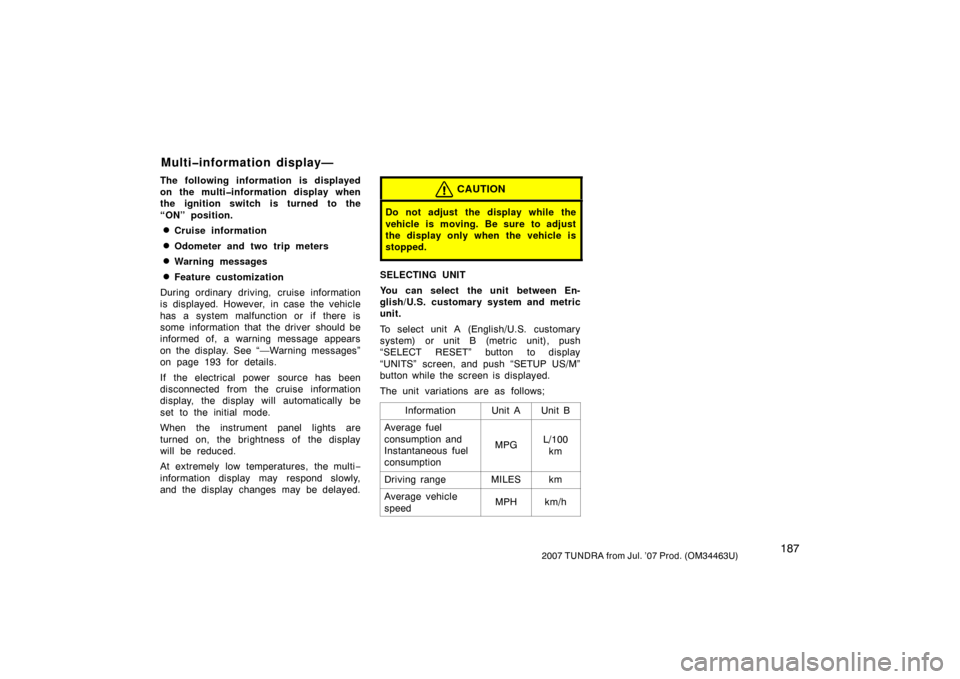
1872007 TUNDRA from Jul. ’07 Prod. (OM34463U)
The following information is displayed
on the multi�information display when
the ignition switch is turned to the
“ON” position.
�Cruise information
�Odometer and two trip meters
�Warning messages
�Feature customization
During ordinary driving, cruise information
is displayed. However, in case the vehicle
has a system malfunction or if there is
some information that the driver should be
informed of, a warning message appears
on the display. See “—Warning messages”
on page 193 for details.
If the electrical power source has been
disconnected from the cruise information
display, the display will automatically be
set to the initial mode.
When the instrument panel lights are
turned on, the brightness of the display
will be reduced.
At extremely low temperatures, the multi −
information display may respond slowly,
and the display changes may be delayed.
CAUTION
Do not adjust the display while the
vehicle is moving. Be sure to adjust
the display only when the vehicle is
stopped.
SELECTING UNIT
You can select the unit between En-
glish/U.S. customary system and metric
unit.
To select unit A (English/U.S. customary
system) or unit B (metric unit), push
“SELECT RESET” button to display
“UNITS” screen, and push “SETUP US/M”
button while the screen is displayed.
The unit variations are as follows;
Information
Unit AUnit B
Average fuel
consumption and
Instantaneous fuel
consumption
MPGL/100km
Driving rangeMILESkm
Average vehicle
speedMPHkm/h
Multi�information display—